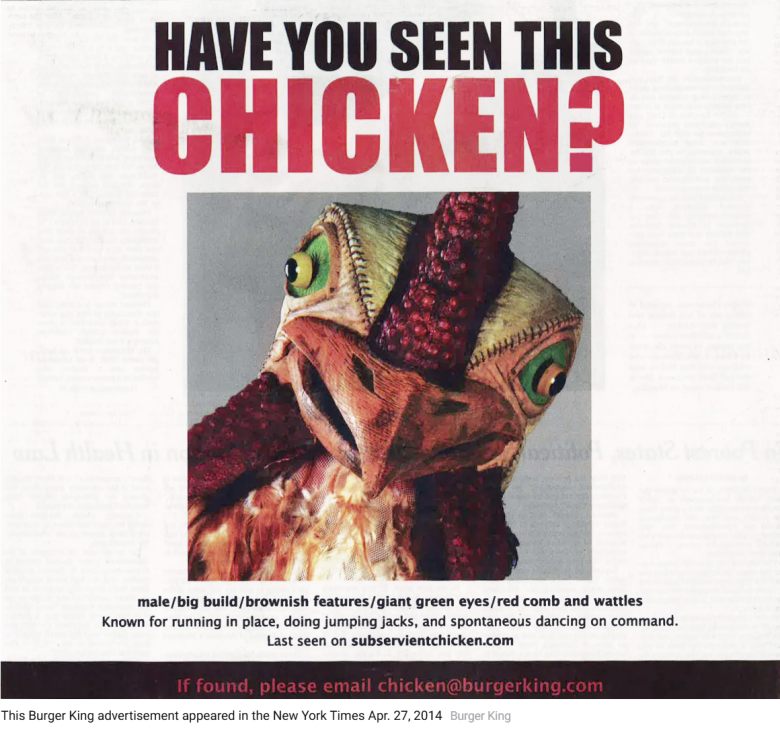
Quick Summary
- Interactive poultry, unlimited potential. Burger King’s “Subservient Chicken” let website visitors command a man in a chicken suit, transforming passive viewers into active participants.
- This chicken went social—years before YouTube and Instagram. The 2004 campaign generated 20 million visits in a week and over 400 million impressions—without a single media buy.
- Marketing takeaway: When you give your audience wings, they often let your brand fly further than you ever imagined.
A Chicken with Chops (and Moves)
In the spring of 2004, Burger King launched a digital stunt that no one saw coming—but nearly everyone ended up seeing. The campaign’s star was a man in a feathered suit waiting in a faux living room, ready to obey your every command.
Visitors to subservientchicken.com typed commands like “sit,” “dance,” or “do karate,” and the chicken carried them out—immediately, awkwardly, and somehow convincingly.
Over 300 pre-recorded video snippets made it feel like users were in control of a truly obedient bird.
The campaign was strange. It was low-res. It was absolutely hilarious. And most of all, it worked—because it was different in all the right ways.

Background: Burger King’s Big Challenge
At the time, Burger King was battling brand fatigue. Its message felt muddled, and its connection with younger consumers was slipping. Competitors like McDonald’s were doubling down on celebrities and sugary soundtracks. Fast-casual concepts were creeping in with healthier halos.
Burger King had a new product to promote—the TenderCrisp Chicken Sandwich—but more than that, it needed a platform to make the brand feel fresh again.
Rather than shouting louder, the company chose to listen better. They partnered with Crispin Porter + Bogusky, a creative agency known for bold ideas and even bolder executions.
To work their tagline “Get chicken just the way you like it,” they cooked up something playful, participatory, and incredibly peculiar.
Campaign Overview: Type, Watch, Laugh, Repeat
SubservientChicken.com launched with zero fanfare. No ad blitz or pop-ups, just a URL passed along from person to person like a digital inside joke.
The experience was magical and weird. A grainy video feed showed a lone chicken standing in what looked like a mid-’90s bachelor pad. Below, a blank command box invited users to “Give the chicken a command.”
The chicken followed orders with impressive precision. Type “jump,” and it jumped. Type “hide,” and it awkwardly crouched behind a chair. Some responses were spot-on, others hilariously off, but that was part of the fun.
The chicken had a behavioral repertoire of more than 300 commands that rewarded exploration.
Before memes were even a thing, Subservient Chicken was a meme machine in disguise. And once it started spreading, there was no stopping it.
The story of the Subservient Chicken, by the creators.
Why It Worked: Interaction, Intrigue, and Absurdity
The campaign succeeded because it invited participation, rewarded curiosity, and delivered a uniquely playful digital experience. It didn’t explain or over-sell—it just let users explore and share, which created both buzz and loyalty.
Here’s a breakdown of the key elements that helped the campaign soar.
Participation turned viewers into users
The experience flipped the traditional script. Instead of broadcasting a message, Burger King handed the controls to its audience. This shift from passive watching to active interaction created a deeper connection.
Every user became part of the story, typing commands and triggering outcomes.
Simplicity created stickiness
The site needed no setup or context. Visitors typed a word and got a reaction. That immediate payoff kept them coming back to try more, share more, and see what else the chicken could do.
A complex backend supported a friction-free frontend—and that made all the difference.
Humor hit the mark
The chicken’s responses were intentionally strange and awkward, tapping into early internet culture’s love of randomness and absurdity. Whether moonwalking or karate-chopping invisible opponents, the character’s unpredictability gave users something they wanted to talk about—and something they wanted others to see.
Illusion of live video added mystery
The interface was convincing enough that many believed it was a real-time webcam. Snopes eventually published an entry clarifying that the chicken wasn’t responding live, but via pre-recorded clips.
That blurring of real and staged made the campaign feel more immersive and surprising.
Character emerged through motion
The chicken never spoke, explained itself, or sold a product directly. Its entire personality came from its movements. That made it accessible to a global audience and highly adaptable across channels. Behavior, not branding, did the heavy lifting.
Design served discovery
The site offered no backstory and minimal framing. Users were dropped into the action and invited to figure it out. This encouraged exploration and made the whole experience feel like a hidden gem.
It felt like something worth passing along—and that’s what users did.
Platform-first planning paid off
Subservient Chicken was different from other brand mascots because instead of being an extension of a TV campaign, it was the main event. Digital was the strategy, not just a tactic. TV spots followed only after the website gained traction.
That reversal of the usual playbook helped the campaign feel fresh and native to the medium.
Earned media amplified the reach
With no initial media spend, the site gained over 20 million visits in its first week. This is particularly impressive when you consider that it happened without likes and shares as we know them today.
The campaign earned press coverage, blog attention, and email shares because it was genuinely fun—and unlike anything else online at the time. Eventually, impressions surpassed 400 million.

New York Times print ad for the 2014 reboot.
Impact and Results
Subservient Chicken showed how a single interactive idea could spark global engagement and help to lay the groundwork for modern digital strategy.
The numbers cluck for themselves:
- 20 million site visits in the first week
- Over 400 million total impressions
- No traditional media buy during launch
- Boosted TenderCrisp sandwich sales
- Generated follow-up campaigns, including a “Chicken Fight” sequel
- Recognized with awards at Cannes Lions and The One Show
- The campaign was so successful that Burger King brought it back in 2014, its 10th anniversary.
Even more impressively, it influenced an entire generation of digital creatives. Subservient Chicken proved that you don’t need to outspend your competition—you just need to outplay them.
The return of Subservient Chicken, 2014.
Marketer Takeaways
- Let your audience lead. People are more likely to engage when they have agency. Design campaigns that invite participation instead of pushing promotion.
- Don’t underestimate simplicity. One basic idea—a chicken obeys commands—carried the whole campaign. It didn’t need bells or whistles.
- Humor fuels sharing. People share what makes them laugh or makes them think. Subservient Chicken gave them both in 30-second bursts.
- Think in behaviors, not banners. Burger King’s shift from message to motion made the campaign memorable.
- Surprise sells. No one expected a chicken to go viral, but that’s exactly why it did.
Media Shower’s AI marketing platform helps you hatch campaign ideas that get attention. Click for a free trial.


